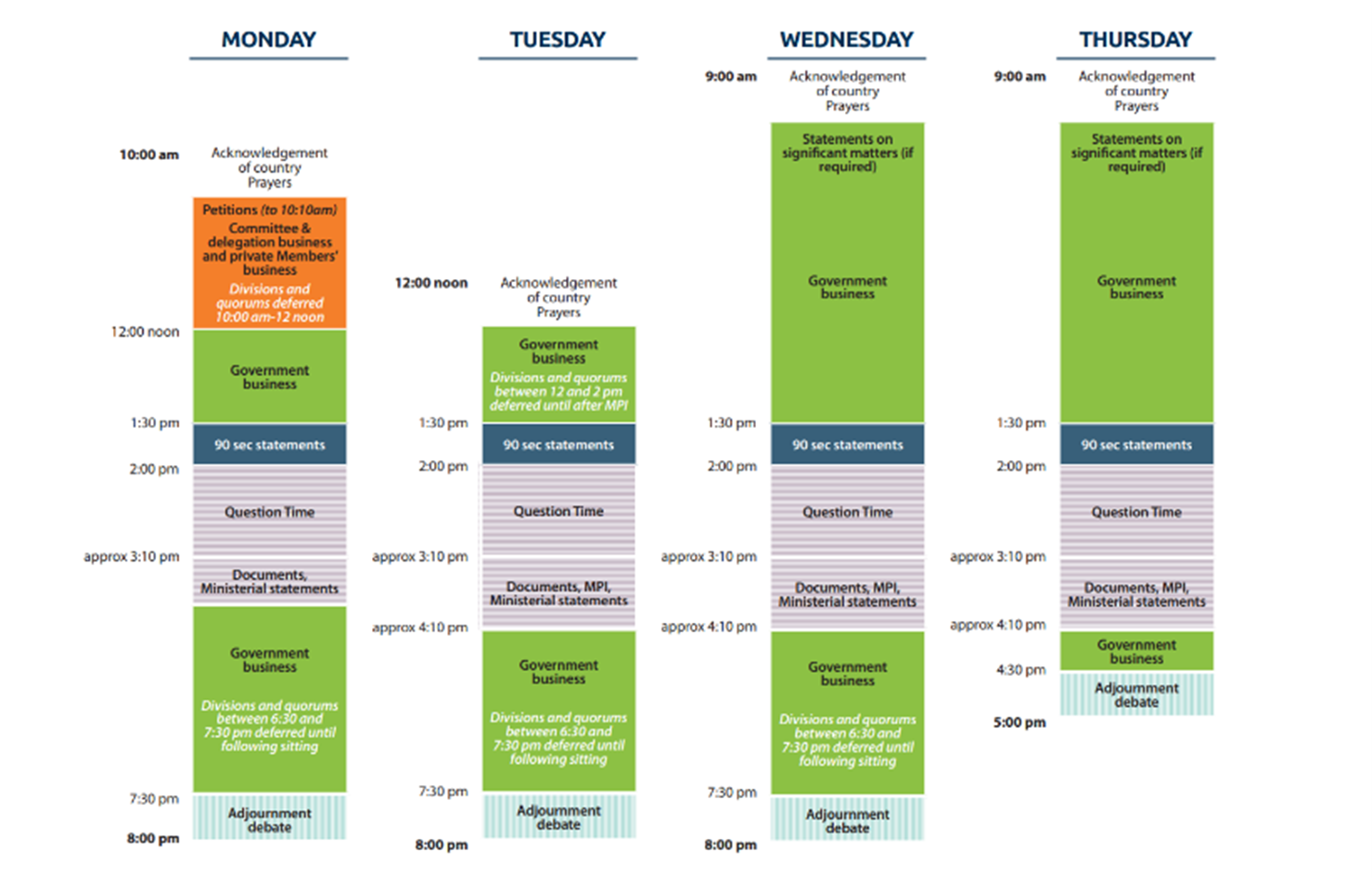When does the House sit?
There are no rules about how many days the House of Representatives must sit (that is, meet) each year. A sitting day is a day where Members of Parliament meet in Parliament House. The House is required to sit regularly so that they can vote on and approve financial proposals.
Since Federation in 1901, the House has sat for an average of 67 days a year, spread over an average of 21 weeks.
The Government proposes a sitting calendar to the House for its agreement. The calendar sets out the proposed sitting dates for that year as well as important dates such as Budget Day.
You can learn more about sitting days here. You can find the current sitting calendar here.
What happens in the House on a typical sitting day?
Sitting weeks in the House of Representatives typically follow the same order of business, which you can see below.
Most of the time of the House is taken up with government business. This would be business such as debating bills (proposed laws).
When the House is sitting, you can watch a live stream of both the House and the Federation Chamber here. You can also view a live draft record of what is happening in both chambers during sitting periods here.

What is Question Time?
Question Time is one of the ways the Australian Parliament scrutinises the work of the Executive Government – the Prime Minister and Ministers.
This is a time when the government is directly held accountable for its actions, and parliamentarians deal with the political issues of the day.
Question Time is scheduled for 2pm every sitting day and usually lasts for just over an hour. Both the House of Representatives and the Senate run their own Question Times.
Watch a video from the Parliamentary Education Office to learn more.
What happens during Question Time?
Members from all sides of politics, including the government, take turns asking questions to the Prime Minister and ministers.
These are called ‘questions without notice’. This is because the Prime Minister and Ministers do not know in advance what questions the Opposition or crossbench will be asking. These questions are often tough, designed to test Ministers' ability to answer quickly and confidently on the spot.
You can watch Question Time live on the APH website at 2pm on sitting days.

What does a committee do?
Just like other parliamentary committees, House Committees are assigned to look into specific topics. They do jobs such as:
- undertake detailed research into the issues
- hear from experts and the community
- analyse information collected
- make recommendations to the Parliament based on the evidence they have collected throughout the inquiry.
Committees will meet to do committee work both during and outside of sitting weeks. They can also meet outside of Canberra to hear from witnesses, or to visit places relevant to their work.
Committees will often write reports about their work to share their findings with the rest of Parliament.
Find out more about House Committees here.
House Standing Committee on Petitions
A committee that is unique to the House of Representatives –the Senate does not have an equivalent – is the House Standing Committee on Petitions.
A petition is a request from the public for the House to take action on something that the Federal government is responsible for. The Parliament receives hundreds of petitions every year. In the picture below, you can see a photo of the Yirrkala petitions, one of the most famous petitions to be presented to the House.
The role of the Standing Committee on Petitions is to:
- receive petitions
- check whether petitions meet requirements to be presented to Parliament
- present petitions in the House during sitting weeks
- send petitions to relevant ministers for response
- present Ministers’ responses to the House
You can sign an existing petition, view all open and closed petitions, or request your own e-petition here.

Want more information?
The House of Representatives infosheets contain more in-depth information about the workings of the House and the roles of those within it. These are suitable for anyone who wants to know more about how the Parliament works.
The Parliamentary Education Office develop and maintain resources to educate Australians about, and inspire their enthusiasm for Australia’s parliamentary democracy. Check out their resources on their website.
Parliament Explained series
This is the final article of the Parliament Explained series. You can find previous articles here. Follow our Facebook page to ensure that you don’t miss any future About the House articles.